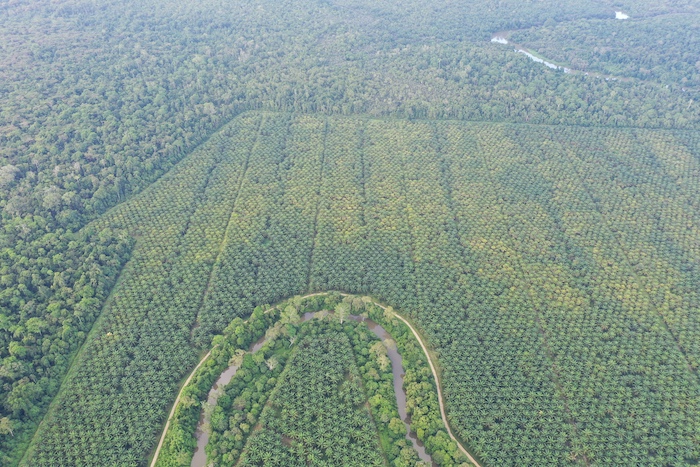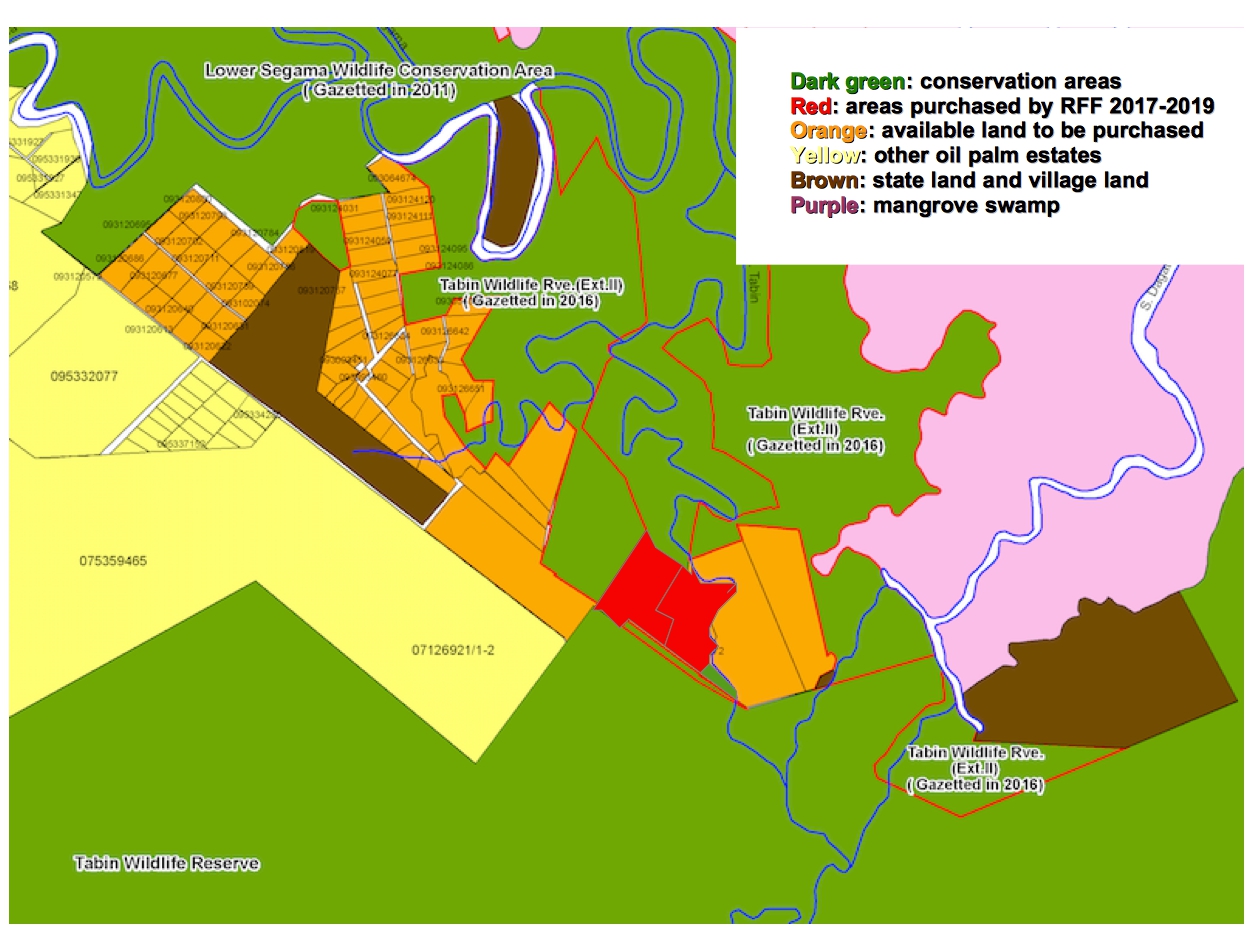- A small project in Malaysian Borneo aims to create a forest corridor between two large protected areas.
- The reforested land comprises an old, legal oil palm plantation, which the Rhino and Forest Fund (RFF) is working to replant with native tree species.
- The corridor is expected to help threatened species move between the Tabin and Kulamba wildlife reserves, including Bornean elephants and banteng, a type of wild cattle.
- RFF says it hopes the project will serve as a blueprint for large-scale oil palm restoration and encourage the “urgently needed restoration of many crucial areas for biodiversity conservation and climate protection.”
In Malaysia’s Bornean state of Sabah, a small NGO is replanting forest over land that was once a legally operating oil palm plantation — essentially reversing time for a small swath of land that, when finished, will reconnect two massive protected areas. The Rhino and Forest Fund (RFF) says the burgeoning 800-meter-wide (2,600-foot) wildlife corridor will benefit numerous endangered species, including Bornean elephants, storm storks, and perhaps the world’s largest remaining population of Bornean banteng (Bos javanicus lowi), a type of wild cattle.
“Our project is probably the first case where private oil palm land has been bought over for protection and restoration,” says Robert Risch, executive director of RFF, who notes that while oil palm plantations have been restored to forest before, it’s usually involved reforesting illegally cultivated plantations, not legal ones that have been purchased back.

The land in question sits between Tabin Wildlife Reserve and Kulamba Wildlife Reserve and will provide the first land connectivity between these two protected areas in decades. Both Tabin and Kulamba are surrounded entirely by either oil palms or mangrove swamps, making it difficult, if not impossible, for some species to cross between these two areas. RFF says it hopes its new work will change that.
“The location of the purchased land parcels couldn’t be better,” Risch notes.
To complete the project, RFF purchased 65 hectares (160 acres) of land using donations: 50 hectares (124 acres) of a standing oil palm plantation and the rest forest. As a foreign NGO operating in Malaysia, RFF cannot not legally own the land, so it “established a new procedure to acquire and to protect private land in Sabah,” according to Risch.
Here’s how it works: RFF raises funds for the land in question. Then the Sabah Forestry Department (SFD) acts as the trustee, handling payments and compensations to current landowners. Finally, SFD and other departments handle gazetting of the land via legislation.

RFF and SFD have used this process four times to purchase land since 2017. The 65-hectare project will connect Tabin Wildlife Reserve’s 130,000 hectares (321,200 acres) with Kulamba Wildlife Reserve, which is a part of the Lower Kinabatangan-Segama Wetlands, made up of around 70,000 hectares (173,000 acres). In all, this could mean around 200,000 hectares (494,200 acres) reconnected by land.
“One thing is clear to me: if we really want to stop impending large-scale biodiversity loss … the restoration of oil palm plantations is an essential key element of a sound strategy,” Risch says.
Reconnected populations
Risch says the number one wildlife beneficiary of this reforestation project will likely be the Bornean banteng, a subspecies of the wild cattle found today in pockets of Southeast Asia.
“Kulamba [Wildlife Reserve] is likely the last place with a Bornean banteng population of more than 100 individuals. Tabin [Wildlife Reserve] has at least another 50 individuals. Combined, these populations might soon be the last hope for the Bornean banteng,” Risch says. He adds there may be 250-300 other Bornean banteng in Sabah, but they are “scattered in small isolated populations.”

Risch notes that, elsewhere in Borneo, the banteng are extinct in the Malaysian state of Sarawak and the small nation of Brunei, and “we don’t see any reason for much hope anymore” for the species in Indonesian Borneo.
If the separate populations of Tabin and Kulamba can be reunited, it may provide the best hope for the long-term survival of the subspecies.
It’s not just banteng, though. Risch notes that the very land being reforested has seen Bornean elephants attempting to cross through the oil palms. Oil palm plantations can be deadly places for elephants and other wildlife, which the owners view as pests and sometimes poison or shoot.
The Bornean elephant is generally lumped in with either the Indian or Sumatran subspecies of Asian elephants (Elephas maximus indicus or E. m. sumatranus), though some researchers contend it should be considered a distinct subspecies, E. m. borneensis.
Risch says the project should also help the endangered Storm’s stork (Ciconia stormi), the hairy-nosed otter (Lutra sumatrana), the otter-civet (Cynogale bennettii), as well as the critically endangered helmeted hornbill (Rhinoplax vigil).

Risch says connecting and protecting large landscapes like these are the only way to save wildlife for the future. He likens the small isolated pockets of forest that dot much of Sabah to “sinking rescue vessels.”
“The inhabitants of these islands are more or less saved for the moment, but if these islands of life remain isolated for too long they will … lose their diversity,” he says. If these islands can be extended and connected, he adds, “life can prevail and hopefully spread on a landscape level again in better times to come.”
Restoring monoculture to true forest
Reforesting the area isn’t simply a matter of planting a few trees. Instead, RFF is attempting to transform the area back into an enhanced tropical forest.
“Diversity is most important,” Risch says, which is the exact opposite of many tree-planting schemes that often focus on a single or a few species. “The species composition should reflect different functions of different tree species for the ecosystem that we want to restore.”

Currently the team is planting around 30 different native tree species, many of them from seeds collected from surrounding rainforest.
One key family of trees that require extra care are Dipterocarpaceae species. According to Risch, trees in this family make up about 80% of the canopy of the type of lowland forest they’re remaking. Unusually for the tropics, Dipterocarpaceae species are wind-dispersed, which Risch says would mean it would take decades for these species to return naturally to reclaimed land. Moreover, such trees would quickly be overcome by pioneer plants if left untended. To ensure the successful replanting of Dipterocarpaceae, Risch says they will have to be maintained for at least five years.
“We will regularly cut climbers and creepers and reduce other competing vegetation around any tree growing on the site to boost the growth of natural regeneration,” he says.
The team is also keeping many of the oil palm trees standing on the site for the next few years, because these trees will provide shade and pillars for young figs to climb. Essentially, the leftover oil palm plantation will aid in growing the new forest.

“Of course, you can never bring back a thousand years of old trees in a few years or copy and paste the diversity of a virgin forest,” Risch says. “But we will at least achieve a functional wildlife corridor and habitat for endangered flora and fauna.”
Even more so, though, the project hopes to create specific sites for threatened species, sites that wouldn’t necessarily show up in a similar patch of ecosystem, including a significant number of fruit trees, grassland areas, and small water bodies.
“The restored area will eventually become more efficient and valuable for wildlife than natural forest of the same size,” Risch says.
A blueprint for the future
The road to the planting, which began this year, has been a long one.
“The project had to grow for around one decade until we reached the point where we had the necessary network, credibility, institutional support, expertise, funding and capacity to buy crucial land and to start converting oil palm back into forest to fix habitat connectivity,” Risch says. “The project is like a tree: if you plant a tree you cannot expect it to fruit next year. And now it seems like we have planted the right tree at the right time at the right spot.”

Although the project will connect two large protected areas, Risch says he hopes it also does something else: plant a seed in the public’s mind of what’s possible.
“We hope that this pilot project will be the blueprint for large-scale oil palm restoration in the future and it will help to inspire, facilitate and speed up the urgently needed restoration of many crucial areas for biodiversity conservation and climate protection,” he says.
RFF is planning to start a research project to compare different restoration approaches to find out the best methods for turning oil palm plantations back into forest.
“The generated know-how will help to facilitate further oil palm restoration all over Sabah and beyond,” Risch says.
Oil palm plantations currently cover more than 1.5 million hectares (5 million acres) of Sabah — or about 20% of the total Malaysian state. Meanwhile, Sabah has a goal of protecting 30% of its land by 2025. Some of this, especially if strategically done to ensure wildlife corridors, could include other oil palm plantations.
“There is no limit but funding,” Risch says of the potential of future reforestation projects.
Jeremy Hance is a columnist for Mongabay and the author of Baggage: Confessions of a Globe-trotting Hypochondriac.

